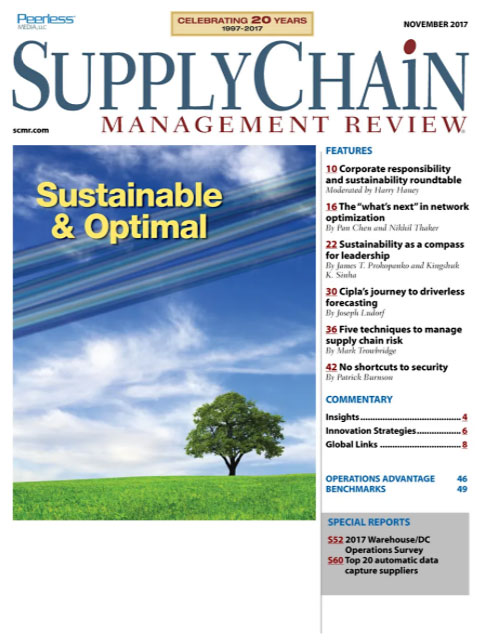Sorry, but your login has failed. Please recheck your login information and resubmit. If your subscription has expired, renew here.
November 2017
There are strands of sustainability and corporate responsibility through much of this month’s issue. James T. Prokopanko, the former CEO and president of The Mosaic Company, details how corporate responsibility became his compass for leader ship when he took over the reins of the company back in 2007. Similarly, Joseph Ludorf, the executive director of supply chain for Cipla Medpro, details how revamping the planning process enables the South African pharmaceutical company to prof- itably supply drugs to underserved populations on the continent as part of its corporate mission. We round out the issue with five tips for intelli- gent risk taking in… Browse this issue archive.Need Help? Contact customer service 847-559-7581 More options
In the business of supplying life-saving medicines, nothing matters more than getting the right items to the right places on schedule. When that doesn’t happen, poor forecasting and stock-outs are often the crux of the problem.
But the pharmaceutical supply chain is a little more complicated than managing just those planning variables at Cipla Medpro South Africa, where I am the director of supply chain operations.
We are constantly confronted with product limitations ranging from temperature control requirements to expiration dates. Both create their own supply chain challenges in Africa. And then there are the seemingly endless regulations from international and local agencies. These include standards from the World Health Organization and the South African Medicines Control Council, not to mention many local pharmaceutical and manufacturing standards.
We also have to factor in very long lead times for imported products and demand spikes from government contract tenders. And on the delivery side, we are faced with immense logistical difficulties that range from unpaved roads to armed bandits.

This complete article is available to subscribers only.
Log in now for full access or start your PLUS+ subscription for instant access.
SC
MR
Sorry, but your login has failed. Please recheck your login information and resubmit. If your subscription has expired, renew here.
November 2017
There are strands of sustainability and corporate responsibility through much of this month’s issue. James T. Prokopanko, the former CEO and president of The Mosaic Company, details how corporate responsibility… Browse this issue archive. Download a PDF file of the November 2017 issue.In the business of supplying life-saving medicines, nothing matters more than getting the right items to the right places on schedule. When that doesn't happen, poor forecasting and stock-outs are often the crux of the problem.
But the pharmaceutical supply chain is a little more complicated than managing just those planning variables at Cipla Medpro South Africa, where I am the director of supply chain operations.
We are constantly confronted with product limitations ranging from temperature control requirements to expiration dates. Both create their own supply chain challenges in Africa. And then there are the seemingly endless regulations from international and local agencies. These include standards from the World Health Organization and the South African Medicines Control Council, not to mention many local pharmaceutical and manufacturing standards.
We also have to factor in very long lead times for imported products and demand spikes from government contract tenders. And on the delivery side, we are faced with immense logistical difficulties that range from unpaved roads to armed bandits.
SC
MR


Latest Supply Chain News
Latest Podcast

 Explore
Explore
Procurement & Sourcing News
- Strengthening customer fulfillment: Building a strategic stakeholder network
- Trump picks former Wisconsin congressman Sean Duffy for DOT secretary
- Made in Mexico, manufactured by China
- Retail sales see gains in October, reports Commerce and NRF
- Geopolitical readiness in supply chains: Strategic challenges for leaders
- With capacity to spare, logistics real estate demand remains subdued
- More Procurement & Sourcing
Latest Procurement & Sourcing Resources

Subscribe

Supply Chain Management Review delivers the best industry content.

Editors’ Picks





